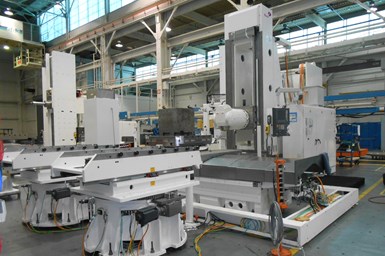Fives Debuts New Machining Center With Five-Axis Tilt Head
Fives’ new Giddings & Lewis HMC 1250 with Liné Machines’ five-axis tilt head provides a flexible, modular horizontal machining center for metal and composite machining.
Share



Fives says its new Giddings & Lewis HMC 1250 with Liné Machines’ five-axis tilt head provides the most flexible horizontal machining center solution on the market. This combination brings together Liné Machines’ high-speed tilt head technology used in its high-performance gantry machines and the consistency of the Giddings & Lewis Horizontal Machining Center.
Fives says this combination delivers adaptable configurations across a wide range of applications. The company provides options for both a 27,000 rpm HSK63 spindle for high-speed machining of aluminum and a 15,000 rpm HSK100 spindle for more general-purpose machining of hard and soft materials, while also providing options for machining titanium and composites.
The machine build offers x-axis travel of 2,100 mm (82.7"); z-axis column travel of 2,350 mm (92.5") on the tilt spindle; y-axis headstock travel of 1,800 mm (70.9") on the tilt spindle; a-axis spindle tilt travel of 120 degrees; and a built-in contouring rotary table with a programmable mechanical clamp, 360,000 index positions in .001-degree increments and a rotary b-axis feed of 0-6 rpm. Also included is an automatic chain-type tool changer with 120 tool pockets and a max tool weight of 25 kg (55.1 lbs), process monitoring, probing systems and a high-pressure coolant system with basic components such as dual-chip conveyors and a full-enclosure must collection.
Fives promises that almost every aspect of this machine is configurable to suit the application. The company offers numerous choices for spindles, head travels, tool changers, coolant systems, control options and other tools to suit usage needs.
Related Content
-
Additive/Subtractive Hybrid CNC Machine Tools Continue to Make Gains (Includes Video)
The hybrid machine tool is an idea that continues to advance. Two important developments of recent years expand the possibilities for this platform.
-
The Power of Practical Demonstrations and Projects
Practical work has served Bridgerland Technical College both in preparing its current students for manufacturing jobs and in appealing to new generations of potential machinists.
-
Inside a CNC-Machined Gothic Monastery in Wyoming
An inside look into the Carmelite Monks of Wyoming, who are combining centuries-old Gothic architectural principles with modern CNC machining to build a monastery in the mountains of Wyoming.
-02.jpg;maxWidth=728;quality=90)












-02.jpg;maxWidth=300;quality=90)


 (1).png;maxWidth=300;quality=90)



